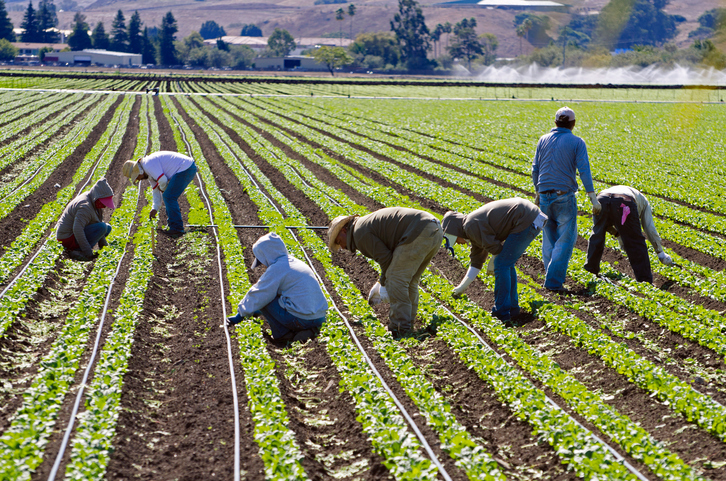"It's a catastrophe, it really is," said Tony DiMare, a long-time tomato grower based in Palm Beach County, Fla.
DiMare said he let 10 million pounds of tomatoes rot on the farm in a region south of Miami because no market existed for them.
"It's been a disaster at every level -- lost crops, lost sales, lost packing inventory," DiMare said.
The closure of food-service establishments in many parts of the country in March meant that farmers who grow produce for those customers suddenly had a large surplus in storage and in the fields.
Growers said efforts to find retailers or food banks failed, forcing them to plow under their crops. Without immediate aid from government stimulus funding, they said they will have to destroy more food.
Growers felt the pandemic impact early in tourism-dominated Florida, where many farms sold directly to the local hospitality industry. South Florida is a major producer of winter vegetables, which are harvested when much of the rest of the country isn't growing produce.
"It will be hard to continue as we have been unless we can get relief from the [federal] stimulus package or business interruption insurance," DiMare said.
The largest trade group for produce growers, the United Fresh Produce Association, is trying to persuade the U.S. Department of Agriculture to distribute aid to its members quickly, said Mary Coppola, the association's vice president of marketing and communications.
"We're trying to open channels where we can with national retailers, in case one of their distribution centers can take produce," Coppola said. "We're talking to schools and food banks, even if we're only giving away food."
A USDA representative said via email, "We are swiftly evaluating the authorities granted under [the stimulus package] and will leverage our programs to alleviate disruption as necessary."
DiMare and other produce farmers -- already dealing with rising foreign competition -- now face a disastrous year and loss of income.
"Farmers are very resilient. But this is new territory," said Toby Basore, one of the largest lettuce growers in the eastern United States, also based in Palm Beach County. "If the crews start getting sick, who is going to harvest the crops."
Produce grower Paul Allen, who oversees 8,000 acres of farms in Palm Beach County, said he plowed under a million pounds of green beans there in March. Allen said food banks in the region already were overwhelmed with produce donated by the state's shuttered tourism and food-service industries.
'Nowhere for it to go'
"When the restaurants are shut down, there's just nowhere for it to go," said Allen, who also is chairman of the Florida Fruit & Vegetable Association.
Allen said he donates regularly to food pantries and that he hates to destroy crops, but he couldn't face the expense of harvest with nowhere to send the crop. That's partly because green beans are highly perishable, and about half the crop in Florida normally goes to hotels and restaurants that are, for the most part, closed or doing little business.
On the West Coast, demand for fresh vegetables also plummeted in the rich cropland near the San Francisco metropolitan area, said Chris Valadez, president of the Grower-Shipper Association of Central California.
"Demand from restaurants or food service is way down," said Valadez, who represents about 300 farms and processing companies. "We are trying to shift strategy away from food service and to retail outlets, but it doesn't happen overnight."
He said many retail businesses saw a surge in buying as people stocked up to isolate at home, but even that has dropped off.
The major harvest season for the Salinas Valley begins in a few weeks, he said.
Cost to donate
"Some of the harvest can be donated, but the costs involved in harvest would be tremendous for that volume," Valadez said. "The only thing that can help is government funding through the stimulus packages that were recently approved. Hopefully, we will see that soon."
He would rather see direct payments to farmers to make up for economic losses, but he said some government money might go to schools and institutions that would buy the fresh produce.
By contrast, farmers in the colder northern regions of the United States don't have the same immediate trouble. Some have started donating stored, surplus grain to processors who wrote checks to food banks, according to the Illinois Farm Bureau.
"I saw that food banks were getting pinched by a lack of donations and higher demand. It was clear that the situation would only get worse as time goes on," said Nik Jakobs, whose family's farm is about 120 miles west of Chicago.
Demand at those food banks is growing, but unpredictable, said Steve Ericson, executive director of Feeding Illinois, a statewide network of food banks. He said some local greenhouses donated produce, but food banks in his area still could use more.
"Our food banks are seeing 20 percent increases in demand, generally," Ericson said. "When we set up drive-throughs, we are getting 50 percent more people than expected."













